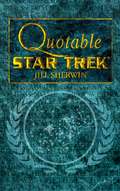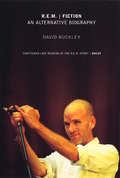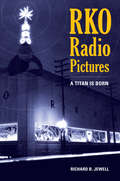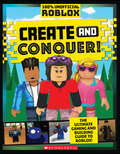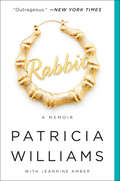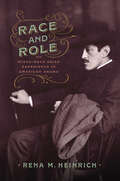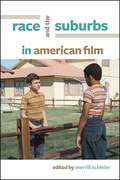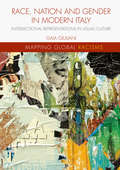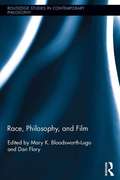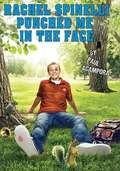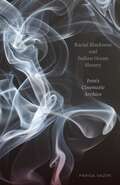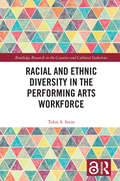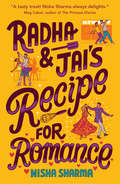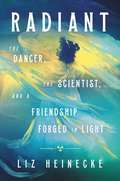- Table View
- List View
Quotable Star Trek (Star Trek)
by Jill SherwinOrganised into categories such as friendship, diplomacy and management, Quotable Star Trek demonstrates the truly universal appeal of Gene Roddenberry's extraordinary creation. Words of wit, wisdom and compelling insight applicable to everyday life have been selected from over 500 hours of television episodes and eight Star Trek motion pictures. For more than thirty years the Star Trek universe has used its much-loved characters and consistently literate scripts to argue thought-provoking ideas, to tackle moral dilemmas, to deal with issues of humanity and responsibility, or to come up with intriguing solutions to seemingly intractable problems. Quotable Star Trek selects over 300 pages of gems which together encapsulate that unique and inimitable spirit.
Quotenkiller oder Qualitätsfernsehen?: TV-Serien aus französisch- und spanischsprachigen Kulturräumen (Serienräume – global, lokal, glokal)
by Julien Bobineau Jörg TürschmannDer bisherige Fokus der TV-Serienforschung auf US-amerikanische Produktionen hat gemeinsam mit dem steten Aufstieg innovativer Serienformate aus der Romania zu einer großen Forschungslücke geführt. Der Sammelband versucht diese Leerstellen durch ausgewählte Überblicksbeiträge und Fallstudien zu schließen und zu weiterführenden Forschungen innerhalb der Literatur-, Kultur-, Medien- und Filmwissenschaften anzuregen.
Qué tiempo tan feliz
by María Teresa Campos LuqueQué tiempo tan feliz nos transporta de manera mágica a un pasado que sigue muy presente en nuestras vidas. Las luces y las sombras de artistas, películas, espacios televisivos y canciones que forman parte de la cultura popular de España. ¿Sabías que los «Quince años» del Dúo Dinámico hizo que más de un padre se llevara las manos a la cabeza en los sesenta?, ¿que Los Pecos tuvieron que hacer la mili para dar ejemplo y que Manolo Escobar era conocido no sólo por sus canciones, sino por su forma de besar en el cine? ¿Sabías que María Jiménez fregaba los suelos de las casas en las que le dejaban cantar, que Fórmula V tuvo problemas con la censura, que Arévalo empezó como Bombero torero o que Bustamante es un maniático del orden? Qué tiempo tan feliz reúne para ti los mejores momentos, los más entrañables, divertidos, curiosos, vividos en directo junto a María Teresa Campos, el director del programa, Yusan Acha, el equipo y los invitados, y da cuenta de anécdotas sorprendentes que se revelaron en este espacio por primera vez. Gracias a un estilo ameno rebosante de guiños a un lugar común que nos acerca a pesar de la edad y de las experiencias vividas, Qué tiempo tan feliz nos transporta de manera mágica a un pasado que sigue muy presente en nuestras vidas. Las luces y las sombras de artistas, películas, espacios televisivos y canciones que forman parte de la cultura popular de España y que componen un fresco en el que el ayer y el hoy conviven con naturalidad. La memoria de una época que evoca recuerdos agradables, un tiempo tan feliz. «Este libro bucea en los recuerdos, en la sentimentalidad de los momentos y de las personas que pertenecen a nuestras vidas, en las luces y las sombras de las trayectorias de éxito mientras se acerca al presente, a las generaciones que crecieron con ellos y a las nuevas que tienen interés en descubrir nuestra historia más reciente».María Teresa Campos
R.E.M. Fiction: An Alternative Biography
by David BuckleyR.E.M.'s public image has always been tightly controlled. Icons of anti-celebrity rock, who bacame huge celebrity rock stars, they were, according to the story, the first U.S. post new-wave band who were both commercially successful and cool. Drawing on exclusive interviews with Mike Mills, Peter Buck and other members of R.E.M.'s nuclear family, Fiction re-evaluates the music and career of a group who sold almost no records for the first half of their existence, then became 'the biggest rock group in the world' in the second half.
REBA: MY STORY
by Tom Carter Reba McentireCountry music superstar Reba McEntire describes her Oklahoma childhood as a member of a cattle ranching family, her early days as a performer, her award-winning musical achievements, the tragic loss of her eight band members, and her marriages.NOTE: This edition does not include a photo insert.
RKO Radio Pictures
by Richard B. JewellOne of the "Big Five" studios of Hollywood's golden age, RKO is remembered today primarily for the famous films it produced, from King Kong and Citizen Kane to the Astaire-Rogers musicals. But its own story also provides a fascinating case study of film industry management during one of the most vexing periods in American social history. RKO Radio Pictures: A Titan is Born offers a vivid history of a thirty-year roller coaster of unstable finances, management battles, and artistic gambles. Richard Jewell has used unparalleled access to studio documents generally unavailable to scholars to produce the first business history of RKO, exploring its decision-making processes and illuminating the complex interplay between art and commerce during the heyday of the studio system. Behind the blockbuster films and the glamorous stars, the story of RKO often contained more drama than any of the movies it ever produced.
ROBLOX: The Ultimate Gaming And Building Guide To Roblox!
by DynamoBecome a ROBLOX master with this unauthorized guide! With over 100 color pages of secrets, guides, and more, start your journey to conquering one of the world's most popular video games!Want to up your Roblox skills? Then check out this 100% unofficial guide! Hints, tips, info, quizzes and more, ROBLOX: Create and Conquer has everything you need to become a true master! Want to learn how to make your very own custom RPG or top the charts on the hardest obby's out there? Then grab this guide and prepare to win it all!
Rabbit: The Autobiography of Ms. Pat
by Jeannine Amber Patricia WilliamsThey called her Rabbit. <p><p> Patricia Williams (aka Ms. Pat) was born and raised in Atlanta at the height of the crack epidemic. One of five children, Pat watched as her mother struggled to get by on charity, cons, and petty crimes. At age seven, Pat was taught to roll drunks for money. At twelve, she was targeted for sex by a man eight years her senior. By thirteen, she was pregnant. By fifteen, Pat was a mother of two. <p> Alone at sixteen, Pat was determined to make a better life for her children. But with no job skills and an eighth-grade education, her options were limited. She learned quickly that hustling and humor were the only tools she had to survive. Rabbit is an unflinching memoir of cinematic scope and unexpected humor. With wisdom and humor, Pat gives us a rare glimpse of what it’s really like to be a black mom in America.
Rabindranath Tagore's Theatre: From Page to Stage
by Abhijit SenThis book analyses Rabindranath Tagore’s contribution to Bengali drama and theatre. Throughout this book, Abhijit Sen locates and studies Rabindranath’s experiments with drama/theatre in the context of the theatre available in nineteenth-century Bengal, and explores the innovative strategies he adopted to promote his ‘brand’ of theatre. This approach finds validation in the fact that Rabindranath combined in himself the roles of author-actor-producer, who always felt that, without performance, his dramatic compositions fell short of the desired completeness. Various facets of his plays as theatre and his own role as a theatre-practitioner are the prime focus of this book. This book will be of great interest to students and scholars in Theatre and Performance Studies and most notably, those focusing on Indian Theatre and Postcolonial Theatre.
Race and Cultural Practice in Popular Culture
by Gerald Vizenor Channette Romero Marcel Brousseau José Anguiano Olivia Cadaval James H Cox K. Angelique Dwyer Nicole Guidotti-Hernández Daniela Gutiérrez López Raisa Alvarado Uchima Jaime Guzmán Ruth Y Hsu Mintzi Auanda Martínez-Rivera James WilkeyRace and Cultural Practice in Popular Culture is an innovative work that freshly approaches the concept of race as a social factor made concrete in popular forms, such as film, television, and music. The essays collectively push past the reaffirmation of static conceptions of identity, authenticity, or conventional interpretations of stereotypes and bridge the intertextual gap between theories of community enactment and cultural representation. The book also draws together and melds otherwise isolated academic theories and methodologies in order to focus on race as an ideological reality and a process that continues to impact lives despite allegations that we live in a post-racial America. The collection is separated into three parts: Visualizing Race (Representational Media), Sounding Race (Soundscape), and Racialization in Place (Theory), each of which considers visual, audio, and geographic sites of racial representations respectively.
Race and Radio: Pioneering Black Broadcasters in New Orleans (Race, Rhetoric, and Media Series)
by Bala James BaptisteIn Race and Radio: Pioneering Black Broadcasters in New Orleans, Bala James Baptiste traces the history of the integration of radio broadcasting in New Orleans and tells the story of how African American on-air personalities transformed the medium. Analyzing a trove of primary data—including archived manuscripts, articles and display advertisements in newspapers, oral narratives of historical memories, and other accounts of African Americans and radio in New Orleans between 1945 and 1965—Baptiste constructs a formidable narrative of broadcast history, racism, and black experience in this enormously influential radio market. The historiography includes the rise and progression of black broadcasters who reshaped the Crescent City. The first, O. C. W. Taylor, hosted an unprecedented talk show, the Negro Forum, on WNOE beginning in 1946. Three years later in 1949, listeners heard Vernon "Dr. Daddy-O" Winslow's smooth and creative voice as a disk jockey on WWEZ. The book also tells of Larry McKinley who arrived in New Orleans from Chicago in 1953 and played a critical role in informing black listeners about the civil rights movement in the city. The racial integration of radio presented opportunities for African Americans to speak more clearly, in their own voices, and with a technological tool that opened a broader horizon in which to envision community. While limited by corporate pressures and demands from advertisers ranging from local funeral homes to Jax beer, these black broadcasters helped unify and organize the communities to which they spoke. Race and Radio captures the first overtures of this new voice and preserves a history of black radio's awakening.
Race and Role: The Mixed-Race Asian Experience in American Drama
by Rena M. HeinrichMixed-race Asian American plays are often overlooked for their failure to fit smoothly into static racial categories, rendering mixed-race drama inconsequential in conversations about race and performance. Since the nineteenth century, however, these plays have long advocated for the social significance of multiracial Asian people. Race and Role: The Mixed-Race Experience in American Drama traces the shifting identities of multiracial Asian figures in theater from the late-nineteenth century to the present day and explores the ways that mixed-race Asian identity transforms our understanding of race. Mixed-Asian playwrights harness theater’s generative power to enact performances of “double liminality” and expose the absurd tenacity with which society clings to a tenuous racial scaffolding.
Race and the Animated Bodyscape: Constructing and Ascribing a Racialized Asian Identity in Avatar and Korra
by Francis M. AgnoliRace does not exist in animation—it must instead be constructed and ascribed. Yet, over the past few years, there has been growing discourse on the intersection of these two subjects within both academic and popular circles. In Race and the Animated Bodyscape: Constructing and Ascribing a Racialized Asian Identity in "Avatar" and "Korra," author Francis M. Agnoli introduces and illustrates the concept of the animated bodyscape, looking specifically at the US television series Avatar: The Last Airbender and its sequel, The Legend of Korra.Rather than consider animated figures as unified wholes, Agnoli views them as complexes of signs, made up of visual, aural, and narrative components that complement, contradict, and otherwise interact with each other in the creation of meaning. Every one of these components matters, as they are each the result of a series of creative decisions made by various personnel across different production processes. This volume (re)constructs production narratives for Avatar and Korra using original and preexisting interviews with cast and crew members as well as behind-the-scenes material. Each chapter addresses how different types of components were generated, tracing their development from preliminary research to final animation. In doing so, this project identifies the interlocking sets of production communities behind the making of animation and thus behind the making of racialized identities.Due to its illusory and constructed nature, animation affords untapped opportunities to approach the topic of race in media, looking beyond the role of the actor and taking into account the various factors and processes behind the production of racialized performances. The analysis of race and animation calls for a holistic approach, one that treats both the visual and the aural as intimately connected. This volume offers a blueprint for how to approach the analysis of race and animation.
Race and the Revolutionary Impulse in The Spook Who Sat by the Door (Studies in the Cinema of the Black Diaspora)
by Michael T. Martin, David C. Wall and Marilyn YaquintoIvan Dixon's 1973 film, The Spook Who Sat by the Door, captures the intensity of social and political upheaval during a volatile period in American history. Based on Sam Greenlee's novel by the same name, the film is a searing portrayal of an American Black underclass brought to the brink of revolution. This series of critical essays situates the film in its social, political, and cinematic contexts and presents a wealth of related materials, including an extensive interview with Sam Greenlee, the original United Artists' press kit, numerous stills from the film, and the original screenplay. This fascinating examination of a revolutionary work foregrounds issues of race, class, and social inequality that continue to incite protests and drive political debate.
Race and the Suburbs in American Film (SUNY series, Horizons of Cinema)
by Merrill SchleierThis book is the first anthology to explore the connection between race and the suburbs in American cinema from the end of World War II to the present. It builds upon the explosion of interest in the suburbs in film, television, and fiction in the last fifteen years, concentrating exclusively on the relationship of race to the built environment. Suburb films began as a cycle in response to both America's changing urban geography and the re-segregation of its domestic spaces in the postwar era, which excluded African Americans, Asian Americans, and Latinx from the suburbs while buttressing whiteness. By defying traditional categories and chronologies in cinema studies, the contributors explore the myriad ways suburban spaces and racialized bodies in film mediate each other. Race and the Suburbs in American Film is a stimulating resource for considering the manner in which race is foundational to architecture and urban geography, which is reflected, promoted, and challenged in cinematic representations.
Race under Reconstruction in German Cinema
by Angelica FennerRace Under Reconstruction in German Cinema investigates postwar racial formations via a pivotal West German film by one of the most popular and prolific directors of the era. The release of Robert Stemmle's Toxi (1952) coincided with the enrolment in West German schools of the first five hundred Afro-German children fathered by African-American occupation soldiers. The didactic plot traces the ideological conflicts that arise among members of a patrician family when they encounter an Afro-German child seeking adoption, herein broaching issues of integration at a time when the American civil rights movement was gaining momentum and encountering violent resistance.Perceptions of 'Blackness' in Toxi demonstrate continuities with those prevailing in Wilhelmine Germany, but also signal the influence of American social science discourse and tropes originating in icons of American popular culture, such as Uncle Tom's Cabin, Birth of a Nation, and several Shirley Temple films. By applying a Cultural Studies approach to individual film sequences, publicity photos, and press reviews, Angelica Fenner relates West German discourses around race and integration to emerging economic and political anxieties, class antagonism, and the reinstatement of conventional gender roles.The film Toxi is now available on DVD from the DEFA Film Library.
Race, Nation and Gender in Modern Italy: Intersectional Representations In Visual Culture (Mapping Global Racisms)
by Gaia GiulianiThis book explores intersectional constructions of race and whiteness in modern and contemporary Italy. It contributes to transnational and interdisciplinary reflections on these issues through an analysis of political debates and social practices, focusing in particular on visual materials from the unification of Italy (1861) to the present day. Giuliani draws attention to rearticulations of the transnationally constructed Italian ‘colonial archive’ in Italian racialised identity-politics and cultural racisms across processes of nation building, emigration, colonial expansion, and the construction of the first post-fascist Italian society. The author considers the ‘figures of race’ peopling the Italian colonial archive as composing past and present ideas and representations of (white) Italianness and racialised/gendered Otherness. Students and scholars across a range of disciplines, including Italian studies, political philosophy, sociology, history, visual and cultural studies, race and whiteness studies and gender studies, will find this book of interest.
Race, Philosophy, and Film (Routledge Studies in Contemporary Philosophy #50)
by Mary K. Bloodsworth-Lugo Dan FloryThis collection fills a gap in the current literature in philosophy and film by focusing on the question: How would thinking in philosophy and film be transformed if race were formally incorporated moved from its margins to the center? The collection’s contributors anchor their discussions of race through considerations of specific films and television series, which serve as illustrative examples from which the essays’ theorizations are drawn. Inclusive and current in its selection of films and genres, the collection incorporates dramas, comedies, horror, and science fiction films (among other genres) into its discussions, as well as recent and popular titles of interest, such as Twilight, Avatar, Machete, True Blood, and The Matrix and The Help. The essays compel readers to think more deeply about the films they have seen and their experiences of these narratives.
Rachel Maddow: A Biography
by Lisa RogakThe first biography of the most popular anchor in cable news.Rachel Maddow has beaten the odds in a way that’s novel in today’s America: she uses her brain. In a world of banal and opinionated soundbites, she regularly crushes Sean Hannity’s ratings thanks to her deeply researched reports. And in our highly polarized world, Maddow amiably engages the staunchest conservatives, while never hesitating to expose their light-on-facts defenses. As a result, she's become the top anchor for MSNBC and a beloved representative for all that progressive America holds dear. The news that Maddow was the first publicly-out lesbian to anchor a prime-time TV news show seemed almost anticlimactic to her millions of viewers, who will be surprised and intrigued by little-known details of her life, as written by New York Times bestselling biographer Lisa Rogak. Growing up in a conservative California town – and viewing herself as a perennial outsider – helped spark an early interest in activism. After attending Stanford and Oxford, she opted for a minimum-wage job as a radio DJ in a tiny Massachusetts market while finishing her Ph.D. She planned to pursue a career as an activist, but 9/11 changed all that, so she returned to local radio where she could help listeners by "explaining stuff." A stint at Air America raised her national profile, which led to her groundbreaking MSNBC show where she dissects the news of the day with an approach found nowhere else on TV.
Rachel Spinelli Punched Me in the Face
by Paul Acampora[From the front dust Jacket flap] "As the new kid in the small town of Falls, Connecticut, Zachary Beatrice could use a friend. Thanks to Rachel Spinelli, he's about to get a whole lot more. Rachel's got a good heart, but she can be ferocious if you taunt her brother, and she's not afraid to throw a punch when necessary. For Zachary, life back in Copper Lake, Colorado, was certainly never this exciting! Now, instead of an isolated existence on the edge of town, he's in the midst of all the action, chatting with regulars at the local diner, playing the trumpet as though his life depended on it, and warding off the punches that inevitably come his way. Best of all, he's figuring out that when life punches you in the face, you just get back on up. From the author of Defining Dulcie, comes a novel about new beginnings, the power of forgiveness, and the quirky people that make life interesting." If you enjoyed this funny, story of real kids working at fitting in to their everchanging world, read Defining Dulcie by this author which is in the Bookshare collection.
Racial Blackness and Indian Ocean Slavery: Iran's Cinematic Archive
by Parisa VaziriRethinking the history of African enslavement in the western Indian Ocean through the lens of Iranian cinema From the East African and Red Sea coasts to the Persian Gulf ports of Bushihr, Kish, and Hurmuz, sailing and caravan networks supplied Iran and the surrounding regions with African slave labor from antiquity to the nineteenth century. This book reveals how Iranian cinema preserves the legacy of this vast and yet long-overlooked history that has come to be known as Indian Ocean slavery. How does a focus on blackness complicate traditional understandings of history and culture? Parisa Vaziri addresses this question by looking at residues of the Indian Ocean slave trade in Iranian films from the second half of the twentieth century. Revealing the politicized clash between commercial cinema (fīlmfārsī) and alternative filmmaking (the Iranian New Wave), she pays particular attention to the healing ritual zār, which is both an African slave descendent practice and a constitutive element of Iranian culture, as well as to cinematic sīyāh bāzī (Persian black play). Moving beyond other studies on Indian Ocean and trans-Saharan slavery, Vaziri highlights the crystallization of a singular mode of historicity within these cinematic examples—one of &“absence&” that reflects the relative dearth of archival information on the facts surrounding Indian Ocean slavery. Bringing together cinema studies, Middle East studies, Black studies, and postcolonial theory, Racial Blackness and Indian Ocean Slavery explores African enslavement in the Indian Ocean through the revelatory and little-known history of Iranian cinema. It shows that Iranian film reveals a resistance to facticity representative of the history of African enslavement in the Indian Ocean and preserves the legacy of African slavery&’s longue durée in ways that resist its overpowering erasure in the popular and historical imagination. Retail e-book files for this title are screen-reader friendly with images accompanied by short alt text and/or extended descriptions.
Racial and Ethnic Diversity in the Performing Arts Workforce (Routledge Research in the Creative and Cultural Industries)
by Tobie S. SteinRacial and Ethnic Diversity in the Performing Arts Workforce examines the systemic and institutional barriers and individual biases that continue to perpetuate a predominately White nonprofit performing arts workforce in the United States. Workforce diversity, for purposes of this book, is defined as racial and ethnic diversity among workforce participants and stakeholders in the performing arts, including employees, artists, board members, funders, donors, educators, audience, and community members. The research explicitly uncovers the sociological and psychological reasons for inequitable workforce policies and practices within the historically White nonprofit performing arts sector, and provides examples of the ways in which transformative leaders, sharing a multiplicity of cultural backgrounds, can collaboratively and collectively create and produce a culturally plural community-centered workforce in the performing arts. Chapter 1 of this book is freely available as a downloadable Open Access PDF at http://www.taylorfrancis.com under a Creative Commons Attribution-Non Commercial-No Derivatives (CC-BY-NC-ND) 4.0 license.
Racine: Drum and Bugle Corps Capital of the World
by George D. FennellMany activities become short-lived fads. Not so for the drum and bugle corps in Racine. Here, after 150 years, drum and bugle corps activity still flourishes as a proud tradition. Racine is the self-proclaimed drum corps capital of the world. Racine had six competing drum and bugle corps during the 1960s and 1970s--very impressive for a community of 90,000. In fact, it would be difficult to find a longtime resident who is unaware of this activity. Everyone in Racine either was a member of or had family or friends who were members of a drum and bugle corps.
Radha & Jai's Recipe for Romance
by Nisha SharmaTo All the Boys I Loved Before meets World of Dance in this delectable love story that combines food, dance, and a hint of drama to cook up the perfect romance.Radha is on the verge of becoming one of the greatest kathak dancers in the world . . . until a family betrayal costs her the biggest competition of her life. Now she has left her Chicago home behind to follow her stage mom to New Jersey. At the Princeton Academy of the Arts, Radha is determined to leave performing in her past and reinvent herself from scratch.Jai is captain of the Bollywood Beats dance team, ranked first in his class, and is an overachiever with no college plans. Tight family funds means medical school is a pipe dream, which is why he wants to make the most out of high school. When Radha enters his life, he realizes she's the exact ingredient he needs for a show-stopping senior year.With careful choreography, both Radha and Jai will need to face their fears (and their families) if they want a taste of a happily ever after."A delicious YA rom-com full of heart, flavor, and just enough heat." --JULIE MURPHY, New York Times bestselling author of Dumplin'"A tasty treat! Nisha Sharma always delights." --MEG CABOT, author of The Princess Diaries"A sumptuous tale of dance, food, and culture. I savored every last page!" --PINTIP DUNN, New York Times bestselling author
Radiant: The Dancer, The Scientist, and a Friendship Forged in Light
by Liz HeineckePart hidden history, part love letter to creative innovation, this is the true story of an unlikely friendship between a dancer, Loie Fuller, and a scientist, Marie Curie, brought together by an illuminating discovery. At the turn of the century, Paris was a hotbed of creativity. Technology boomed, delivering to the world electric light, the automobile, and new ways to treat disease, while imagination blossomed, creating Art Nouveau, motion pictures, and modernist literature. A pivotal figure during this time, yet largely forgotten today, Loie Fuller was an American performance artist who became a living symbol of the Art Nouveau movement with her hypnotic dances and stunning theatrical effects. Credited today as the pioneer of modern dance, she was perennially broke, never took no for an answer, spent most of her life with a female partner, and never questioned her drive. She was a visionary, a renegade, and a loyal friend. In the early 1900s, she heard about Marie Curie's discovery of a glowing blue element and dreamed of using it to dazzle audiences on stage. While Loie's dream wouldn't be realized, her connection with Marie and their shared fascination with radium endured. Radiant is the true story of Marie Curie and Loie Fuller, two revolutionary women drawn together at the dawn of a new era by a singular discovery, and the lifelong friendship that grew out of their shared passion for enlightenment.
